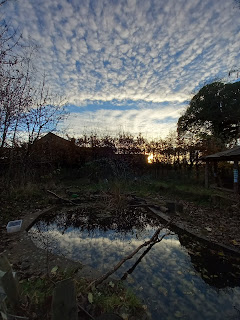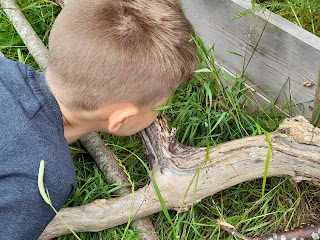Forest School Time and Space
If you follow the ideals of Forest School then you have to accept that not only do different children take different things away from the experience, but that they require a variety of different experiences to meet their needs.
Accepting the 6 principles of Forest School means you accept the children's freedom to explore whatever they choose to do, even if it seems they make the same choices week in and week out. The main point of children having TIME, both in minutes during a session, and in weeks stretched across a year, is to allow them to work through whatever may have them returning to the same behaviour, while offering the opportunity to get involved with many different activities before or after or instead.
As I've said before we're running a type of 'Forest School Lite', which has the benefit of allowing the whole school access to Forest School Activities each week, but the disadvantage of only giving some groups about 30 minutes outside.Some time outside will always be way more beneficial than no time outside, and the children are engaged and thriving within this timetable. However tool use, campfires, knot skills, den building, etc, have all needed to be restricted because of time. Some classes are having a full 90 minutes outside, some only 60, other classes are split into 2 groups, each aiming for 40 minutes of Forest School Lite - but frequently resulting in 30 minutes only.
The difficulty for us currently is some of the upper KS2 children who have reduced sessions with the FSL in the morning and use the space to just MOVE! They need to run, they need to chase, they need to play 'manhunt' and 'hide and seek', they need to get their pent up energy out of their system. This can swallow up their entire session each and every week. There is a growing issue around them seeing 'Forest School' time as extra break time where they can run free of playground rules.
This has led to adult intervention around safety being met with 'attitude', so where do you draw the line between independent choice with children assessing their own risks, and pupils needing to remain safe and accept boundaries?Their focus on 'tag' games has also caused damage to the site. when the chase gets too physical other activities are considered hurdles and hindrance and care and attention disappears.Children, and grown ups, all have their own way of learning, of making sense of the world around us all. When we think of a classroom we think of our senses taking in what is said and seen and what we are asked to do.
When we are outside we are in greater contact with the environment, carpet beneath the feet goes unnoticed, long grass tickles the knees! The way we take in information, albeit visually, auditorily, or tactilely, alters from person to person, our brains process each input at different speeds with different priorities and therefore different ways of learning.
For many of us sitting still and learning isn't a problem, although our time limits before we've had enough may vary! Some of us fidget a lot, some of us have to move in order to concentrate, some of us will sit and focus.... but need to get up as soon as there's a break. Coming outside in a school day can be a reaction to having been sat down for a 'too long', can proceed being in a lesson you 'don't like', is it's own learning experience with a potential sensory overload!The lack of time means the cohesive effect of pulling the group together to start and to finish is less effective because both are as basic as possible. Often seen by our older children as something to be endured and not enjoyed. The opportunity to run out frustrations, to use up pent up energy, and to connect with outdoors is there, but there isn't enough time to move on to something else. No opportunity to share a plenary with classmates and hear different accounts of the session activities.
Our younger children respond much better to sessions. They explore and discover, move and observe, share and engage, and the freedom to choose is welcome but respected. When eyfs get to learn the routines and experience the activities they continue to enjoy the progression of experiences they can access as they go through school. They will sometimes charge about and enjoy an energetic game, but they will also be distracted by the birds, quick to pick up a worm, ready to take a turn at an activity, and are full of questions. This continues into KS1 and can be fostered and will grow. In my experience this can be built on to match a progression of skills and experiences that only Forest School can provide.Older children who haven't had this foundation can and will still make the most of Forest School - but only when it is true Forest School! Without the time to discuss what we have planned and follow their learning, and for the children to see we are using their feedback, what we offer is limited, which in turn limits their engagement.
Of course CoViD restrictions have not helped the situation, and even with a full 2 hour session many activities would still be impossible - however the opportunity to work within guidelines to provide tool use (for instance) disappears because there is no time to do so effectively.
Having said all of this, our current set up isn't a negative experience!
KS1 have also embraced the development. Year 2 had the idea of a Bug Hotel and expanded it to a 'Wildlife Hotel' where hedgehogs can hibernate at the base and birds have space on the top for food and water and maybe even to just perch!
A child who a year ago was very mud phobic instigated the actual build and organised and moved some wet and slimy pallets with a team of helpers to make the stack. Once the main 'building' was intact other's stepped in with the detail, while our architect disappeared to climb trees!
A few children have been keen to be 'helpers' and have learned which tiny twig like tree we're planting is which, and have volunteered to aid their classmates in choosing, digging, planting, using a bamboo stake, and sliding on a tube to safely encase the tree! Many of those children running about have paused to plant a tree of their own.As for those who still need to run we continue with consistent boundaries and clear safety rules, and a focus on respecting all things and all people in Forest School.
We're also hoping the ongoing developments will offer a distraction, that seasonal celebrations will be enjoyed, and if 2021 brings back some proper, quality Forest School sessions then who knows what we could achieve?!
Of course the children will come up with ideas none of us have even dreamed of!










Comments
Post a Comment